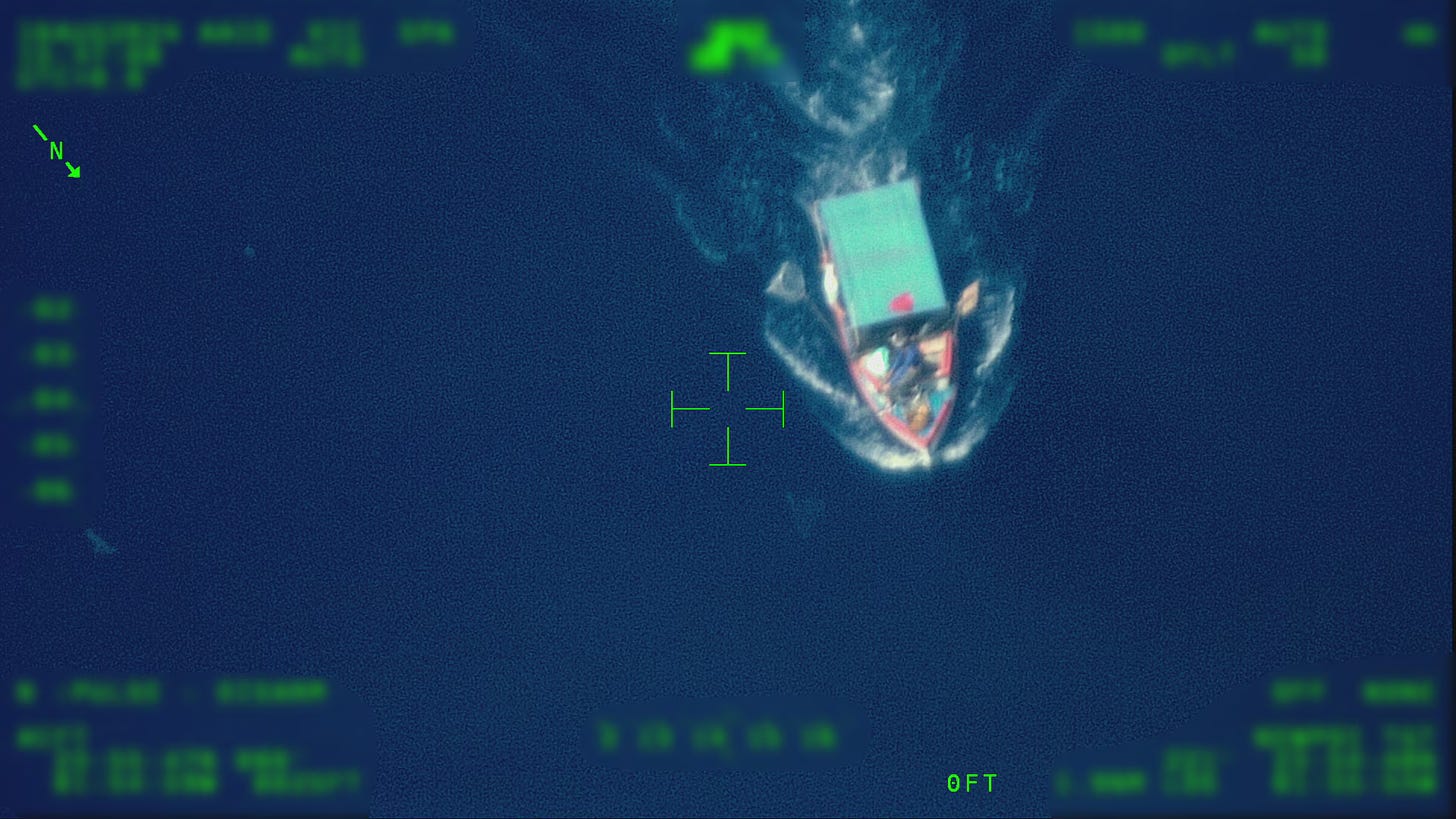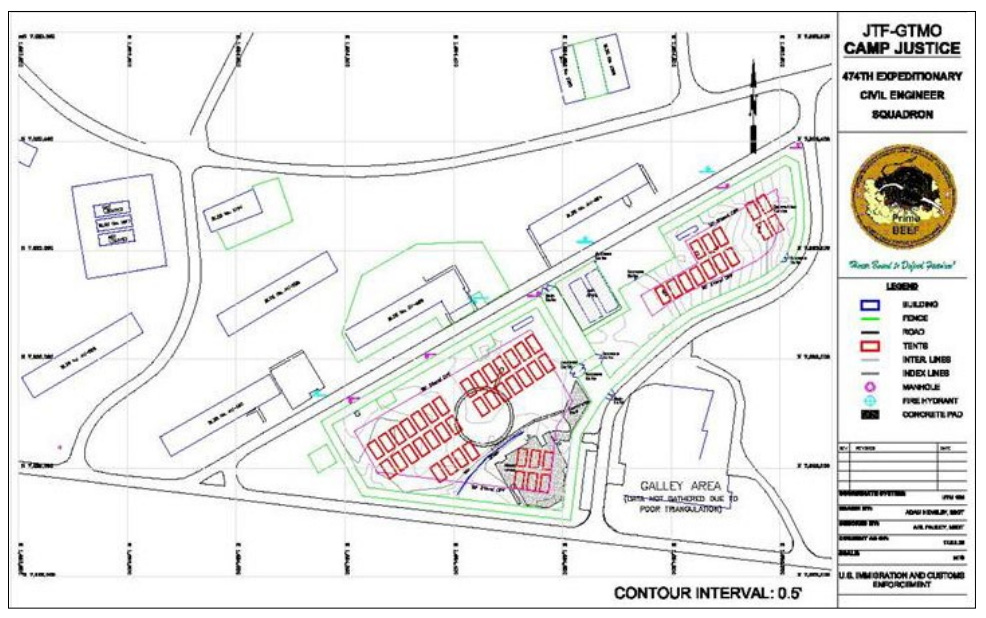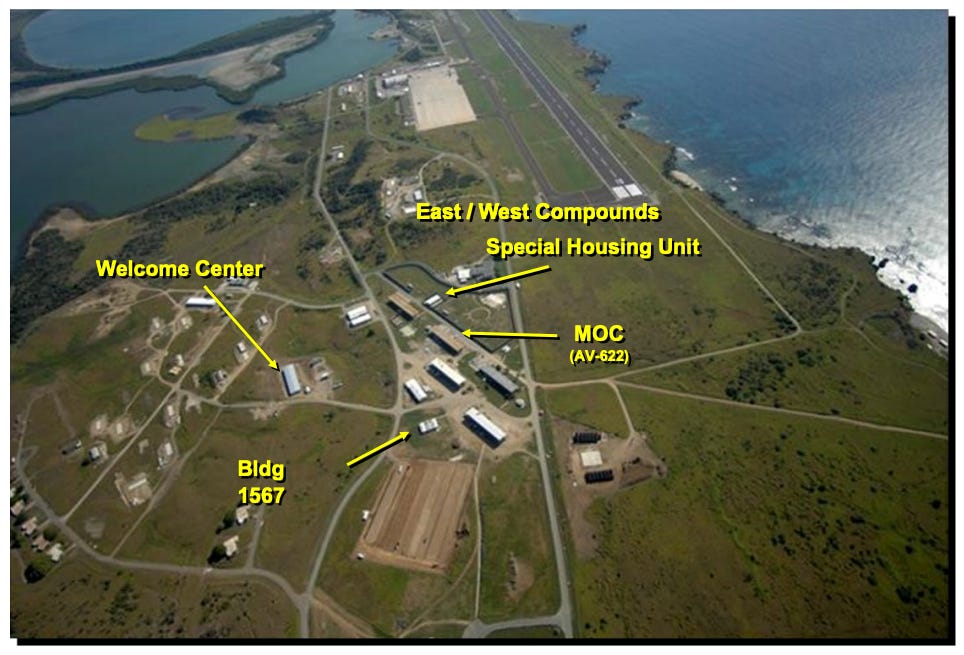"Hand Restraints and Black Out Goggles": Biden Administration Plans for Migrants Held at Guantanamo Bay Revealed
Documents show U.S. government has long used the controversial naval base to house and process refugees, contradicting public statements
In August, the Biden administration finally and quietly signed a $163.4 million contract to maintain a migrant detention center at Guantánamo Bay. The deal had been in the works since 2021, giving the impression that the White House was greenlighting the reopening of the Guantánamo-based facility for detaining migrants found at sea, mostly from Haiti. President Joe Biden has come under fire from advocates for his immigration policies, including expanding detention center contracts and undermining the asylum process.
What the brief announcement of the newly inked contract did not disclose is that the U.S. has been detaining migrants at the secretive facility since the 1990s. Now, records obtained by Drop Site News confirm that the U.S. government has been detaining migrants at the Guantánamo Bay facility for years, including under Biden—with the help of private contractors.
The documents reviewed by Drop Site News include a December 2022 “performance work statement” from the Department of Homeland Security (DHS) and Immigration and Customs Enforcement (ICE), a 2021 document from the U.S. Navy, and multiple contract documents provided to private security companies. The documents were presented to private prison companies during the government’s search for a contractor and are publicly available on a government contracting website.
Between December 2021 and December 2022, the Migrant Operation Center (MOC) at Guantánamo Bay held an average of at least 20 migrants per day, according to a document reviewed by Drop Site News. DHS and ICE hold migrants intercepted in the Caribbean Sea by the U.S. Coast Guard in the MOC before either repatriating them to their home countries or granting them refugee status in a third nation.

The facility is equipped to hold not only single adults, but also families and unaccompanied children. Those awaiting processing or repatriation to their country of origin are transported in black out vans “with hand restraints and black out goggles to obscure their vision,” according to an ICE contracting document. According to a U.S. Navy document from 2021, migrants have limited communication with the outside world, with their few phone calls monitored for “restricted information,” including information about the navy base. Private prison ICE contractors are required to have at least 23 unarmed staff members on-site, dressed in “forest green” polo shirts and carrying batons and pepper spray, the ICE document says.
Among the revelations uncovered by Drop Site News are aerial images of the facility, the names of the private companies running the MOC, and previously unknown details about how the migrant facility is run at the secretive naval base.
Upon arrival at Guantánamo, migrants are separated into categories: protected, non-protected, and undetermined. Protected migrants, those who officials determine will face danger if returned to their country of origin, are placed under State Department custody at the facility and later relocated to a third nation. Non-protected migrants are those that United States Citizenship and Immigration Services (USCIS) officials deem to have no “well-founded fear” of persecution at home and are later repatriated to their home countries. Undetermined migrants are those who have not yet been screened by officials. (Undetermined and non-protected migrants are under ICE custody.) None of the migrants held at Guantánamo are approved to receive asylum in the U.S., which means they never step foot on U.S. soil.
In a statement, an ICE spokesperson confirmed much of Drop Site News’ reporting and included information about the treatment of “protected” migrants. The statement provided little detail about conditions for undetermined or non-protected migrants under ICE custody.
“Protected migrants are neither detained nor imprisoned and are free at any time to return to their country of origin,” ICE told Drop Site News. The agency also said that most protected migrants elect to stay at the MOC until an opportunity to resettle emerges and that they “live in a relatively unrestricted environment, participate in recreational activities, and are allowed to work,” while adding that some “restrictions of movement” can become “necessary due to security concerns.”
ICE did not respond to follow-up questions about the treatment of migrants under their watch.
For some, the MOC has been lucrative. The Biden administration’s new contract to run the MOC, which could run up to five years, went to Akima Infrastructure Protection, a government contractor that runs other ICE facilities.
In the past 20 years, contracts to oversee the MOC have gone to GEO Group, a behemoth in the private prison world, and MVM, a defense contractor. Each company has pocketed millions of dollars managing the Guantánamo MOC, according to documents reviewed by Drop Site News.
In 2021 and 2022, migrant rights organizations criticized the Biden administration after news outlets reported that DHS was bidding for new contractors to run the MOC. At the time, the White House did not specify the number of migrants, if any, that were being held at the MOC.

From 1996 to September 2015, 417 migrants were sent from the MOC to a third country, according to a State Department document. On a monthly basis, the facility held an average population of 16 “protected” migrants, ranging from zero to 48 at one time, and between one to three “non-protected” migrants from 2012 to 2016, according to a separate document.
In 2022, the numbers began to rise: From December 2021 to December 2022, the MOC held an average monthly population of 14 “undetermined” migrants. During that time, there was also an average population of 20 “protected” migrants per day, a document says. The average number of migrants detained in 2023 and 2024 is unclear.
These records demonstrate how Biden appears to be expanding detention at the military base for refugees and migrants, despite saying he hoped to close the Guantánamo military detention facility. Administration officials have also announced the White House’s intention to prepare to expand the Guantánamo MOC in the event of a surge of migrants from Haiti. Separately, the administration has expanded ICE detention by extending private facility contracts on the continental U.S., including for troubled immigration jails with histories of abuse.
“It is nearly impossible to know when people interdicted at sea are transferred to the Guantánamo facility, or to monitor whether they are allowed to exercise their right to seek asylum,” said Jesse Franzblau, a senior policy analyst with the National Immigrant Justice Center. “The ICE detention facility on the Guantánamo Bay U.S. naval base is an egregious illustration of the discriminatory treatment and impunity that is endemic to the profit-driven U.S. immigration detention system.”
Federal immigration detention centers often face allegations of abuse and mismanagement. Located in remote areas, they are often run by private prison companies. Detaining refugees at the U.S. naval base in Guantánamo adds another layer of opacity, preventing advocacy organizations from independently monitoring conditions and services.
Drop Site News found congressionally mandated government inspection reports for more than 200 ICE detention centers in the country dating back to 2011—except for the Guantánamo MOC.
“The Migrant Operation Center on Guantánamo is such a black box that advocacy organizations do not get to visit nor to communicate with migrants there, including recognized refugees, potentially families with children,” said Yael Schacher, the director for the Americas and Europe at Refugees International. “We don’t know how long they are held and under what conditions. So many unknowns.”
In 2023, DHS’s Civil Rights and Civil Liberties office launched an investigation into the apprehension of migrants at sea and their detention at Guantánamo. The status of the investigation remains unclear. DHS did not respond to a request for comment.
Quiet Legacy of Detention
During times of migrant crises, the MOC has served as a something of a pressure valve for Washington. In 1991, Haiti’s military coup forced thousands to flee the ensuing violence and instability. Anticipating a surge of refugees, the U.S. converted a section of the Guantánamo naval base into a camp to “screen” those taken in by the U.S. Coast Guard, which patrols U.S. and international waters for security and rescue missions. From there, migrants would either be classified as refugees or repatriated to their home country. Reports from the 1990s told of “horrendous” conditions at the Guantánamo camp, including rampant illness and rotten food. In 1992, following a public outcry over the conditions, President George H. W. Bush ordered the Coast Guard to stop bringing Haitians to Guantánamo.
The U.S. resumed migrant detention operations at Guantánamo in 1994, in part to handle an influx of Cuban migrants. They were sent to Guantánamo to be processed as refugees before eventually being sent on to a third country. In 1994, the total detainee population peaked, with a total of 20,000 Haitians and 30,000 Cubans detained throughout that year, before coming back down in 1996 after Washington began sending intercepted migrants to Latin American nations. In 2002, President George W. Bush’s administration began using the Guantánamo Bay naval base to imprison War on Terror detainees. That year, he also signed an executive order to send migrants intercepted in the Caribbean to the Guantánamo MOC.
In 2003, GEO Group received a $1.4 million contract to run the MOC for one year, which continued to be extended in years that followed. Nine years later, MVM—which worked with U.S intelligence in Iraq and later faced scrutiny for its treatment of migrant children during the 2018 family separation crisis—landed its first contract, worth $10.8 million for five years. It received a new five-year contract in 2017, worth $32.1 million. That contract has been extended until October of this year.
In 2022, while the MOC was under MVM’s watch, officials found “critical physical and logistical complications” at the site, according to a separate document. The nature of the complications is unclear.
Akima, the private prison company that received a new ICE contract last month, is the subject of a lawsuit for allegedly not paying detained migrants for their labor at its Buffalo, New York-based ICE facility. Akima and MVM did not respond to detailed requests for comment.
Inside the MOC
On national and international waters, the Coast Guard will frequently intercept boats packed with migrants leaving the Caribbean. Oftentimes, the Coast Guard will repatriate migrants to their home countries. From October 23, 2023, through August 21 of this year, it repatriated 507 migrants to Haiti. But if migrants express an explicit fear of returning home—what advocates call a “shout test”—U.S. officials conduct a preliminary screening and take them to the Guantánamo MOC for further processing.
In a statement, a spokesperson with U.S. Southern Command said the MOC “is not a Department of Defense activity,” adding that it falls under the State Department’s purview.
The Guantánamo MOC is divided up into two sections with the capacity to house a total of 120 people: one section for non-protected and undetermined migrants, and the other for protected migrants. DHS and ICE run the former via a private contractor, while the State Department, in partnership with the United Nations’ International Organization for Migration, runs the latter.
In a statement, a State Department spokesperson was emphatic that the MOC is not a detention facility, but rather a humanitarian facility unassociated with the Defense Department. “Protected migrants can request voluntary return to their country of origin anytime. Protected migrants can choose to remain at the MOC and await third country resettlement. Individuals at the MOC have access to recreation and skills building,” the statement said. The United Nations International Organization for Migration did not respond to a request for comment.
A 2021 Navy document says that undetermined migrants are allowed to only make one phone call after arriving at Guantánamo. If they are found to be “protected,” they can only receive two external calls for the duration of their time at Guantánamo. All migrants are allotted only 30 minutes per week of phone usage—all under the strict supervision of Guantánamo staff.
The documents also show that the Guantánamo MOC has a “special housing” unit, a common euphemism for solitary confinement.
“The imposition of restraints in transit, segregation units, the conduct of counts, and the monitoring of communications are the kinds of intrusive restrictions typical of prisons and immigration jails,” said Eleanor Acer, senior director for refugee protection at Human Rights First. “People seeking refugee protection need regular access to phones, email, and other communications with their families and colleagues. Many migrants will have family members who will be desperately worried about their safety, after learning that they fled their country by sea—a notoriously dangerous way to escape.”
In a statement, ICE said that sea interdictions do not bring migrants to the U.S. in order to discourage them from undertaking these “dangerous voyages.” According to ICE, protected migrants, or those who have passed their USCIS interviews, receive “dormitory-style” housing, food, and medical care and have access to banking and mail services, among other amenities. “Protected migrants also receive English language and computer skills training,” the agency said.
The method by which migrants are transferred out of Guantánamo, either to a third country or back to their country of origin, remains unclear. In 2022, Tom Cartwright, a refugee advocate, documented only three ICE flights departing from Guantánamo, all of which were bound for Haiti. It is also unknown what types of services the State Department and United Nations International Organization for Migration provide to “protected” migrants at Guantánamo before they are resettled.
A Growth Opportunity
This year, gang violence in Haiti exploded, leading to a rise in the number of migrants fleeing the crisis. The Biden administration has been bracing for a mass exodus of Haitians, in part by readying the Guantánamo MOC for expansion.
As part of the contracting process, ICE required private contractors Akima and MVM to guarantee that they could expand capacity at the Guantánamo MOC with 48 hours’ notice, for up to 400 migrants, in case of a “surge” of Haitian migrants. The expansion would be a “tent city” next to the facility’s solitary confinement unit. Akima recently posted a job listing for a “program manager” at Guantánamo. It is unclear what the division of labor is, or will be, between the two private prison companies at Guantánamo.
MVM’s current Guantánamo contract will run through October of this year. However, the company recently posted listings for what appear to be security operations positions at Guantánamo. While the location is not named, the posting requests “unarmed security and custody officers” who speak Haitian Creole to be based at an “overseas naval base” while working with migrants.






Lovely. Wreck Haiti for profit then deny them asylum. So the choice in this election is inhumane treatment and deportation or brutal treatment and deportation. Lesser evil is so fine.